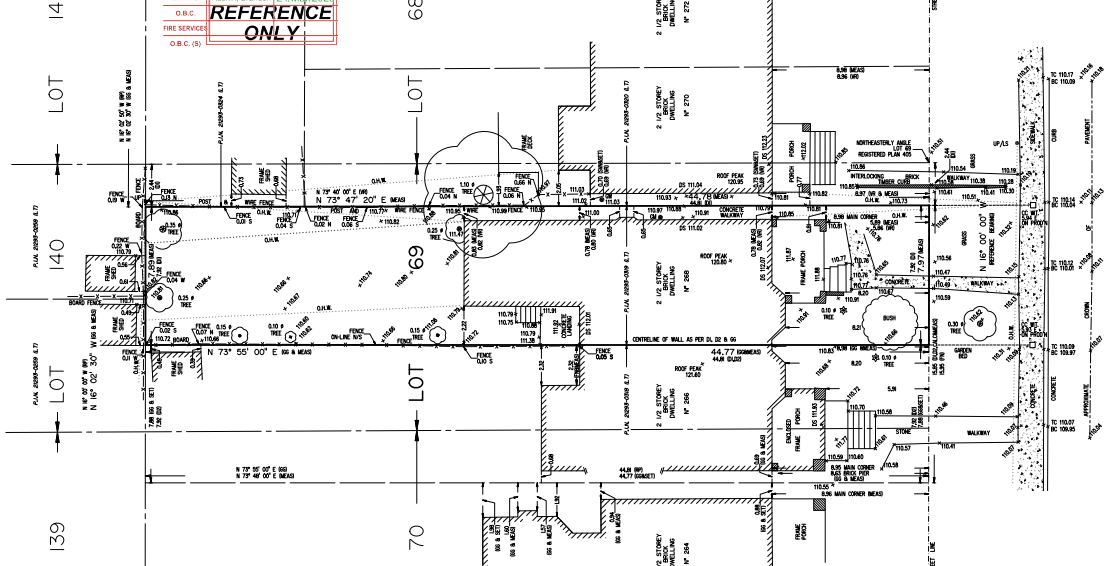This blog explores various insulation types, including spray foam, fiberglass, and mineral wool, analyzing their costs for both materials and labor. We’ll discuss the advantages and disadvantages of each option, providing real examples and current market prices.
Most houses in Toronto are situated on lots that are either 50 feet or 25 feet wide. A typical house would be 20 feet wide by 50 feet long, offering approximately 1000 square feet per floor, totaling two floors above grade. Additionally, the basement is usually the same size as the main floor. Based on this, we’re going to calculate the average price per square foot for insulation.
I have been a drywall contractor in Toronto since 1999 and have worked on approximately 1000 houses, most of which are similar to the ones I’m describing now. I do not work on subdivisions or houses outside the GTA, where the sizes are larger and the work quality does not need to be as high as in Toronto with custom-built houses. In Toronto, due to space limitations, builders typically try to maximize interior space, adhering to the principle that every inch counts.
New Construction House Insulation
Let’s discuss two types of construction: renovations and new builds, which adhere to different parts of the Ontario Building Code—Part 9 for renovations and Part 11 for new builds. According to the Ontario Building Code, every new foundation wall below grade must have R-10 continuous insulation (CI) and R-12 mineral wool or fiberglass batt insulation with a vapor barrier. The R-10 CI, often 2 inches thick and made of Rigid Foam Insulation, creates an envelope for the basement exterior walls to prevent moisture from penetrating the living space, while R-12 provides additional warmth. The vapor barrier must be installed on the warm side of the insulation.
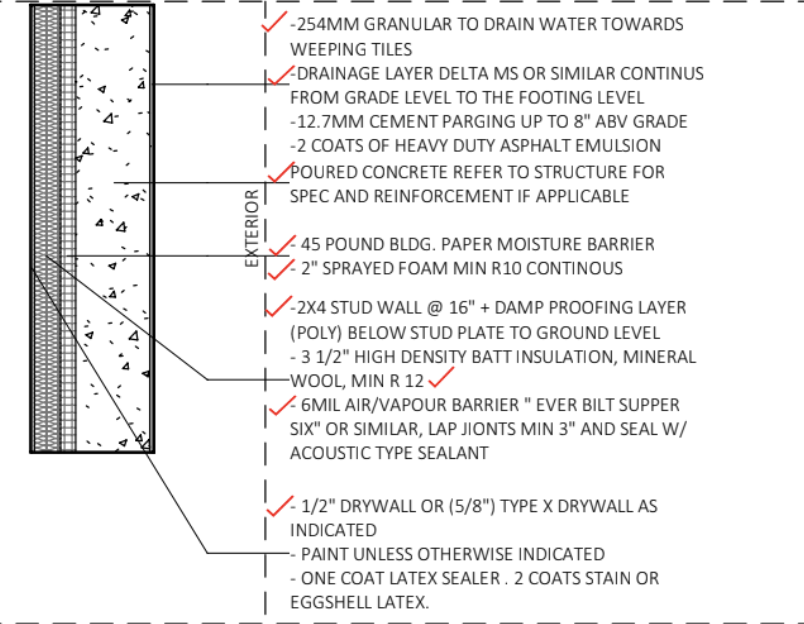
Let’s discuss the cost of insulation and the types that can be used to achieve the required R-value. On average, 2-inch rigid foam insulation with an R-10 value costs approximately $3 per square foot at Home Depot.
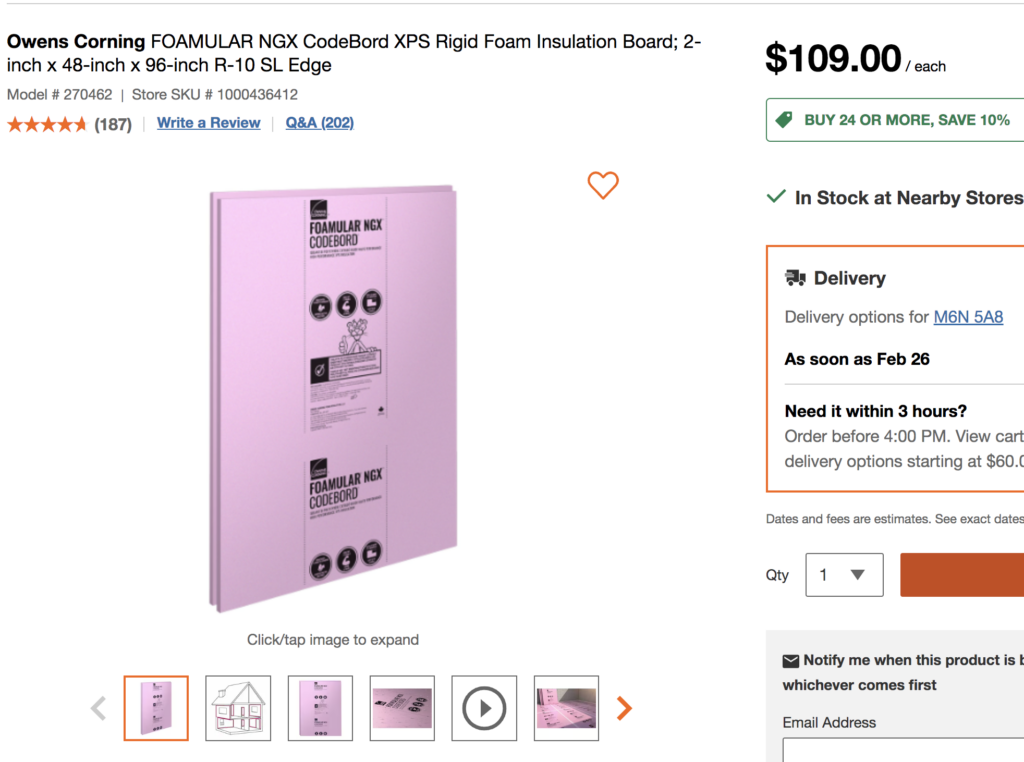
Additionally, installers will charge about $1 to fasten it to the wall. After insulating, the framer constructs the exterior walls with 2x4s, leaving a half-inch gap from the wall. Once all the rough-in work, such as electrical, HVAC, and plumbing, is completed, the installation of mineral wool or fiberglass insulation begins. Since the cavity of the 2×4 is 3.5 inches, it can accommodate either R-12 or R-14 insulation at most. Fiberglass, while cost-effective and easy to install, may not last as long as other insulation types like mineral wool or spray foam. Its low density can lead to sagging due to its weight, creating gaps at the top of the studs that allow airflow directly from the exterior to the drywall, resulting in significant heat loss in winter and the opposite in summer.
Regarding mineral wool, it’s important not to confuse it with the brand name Rockwool, as many companies produce similar mineral wool insulation. For fiberglass insulation, the market price in 2024 is approximately $0.90 per square foot.
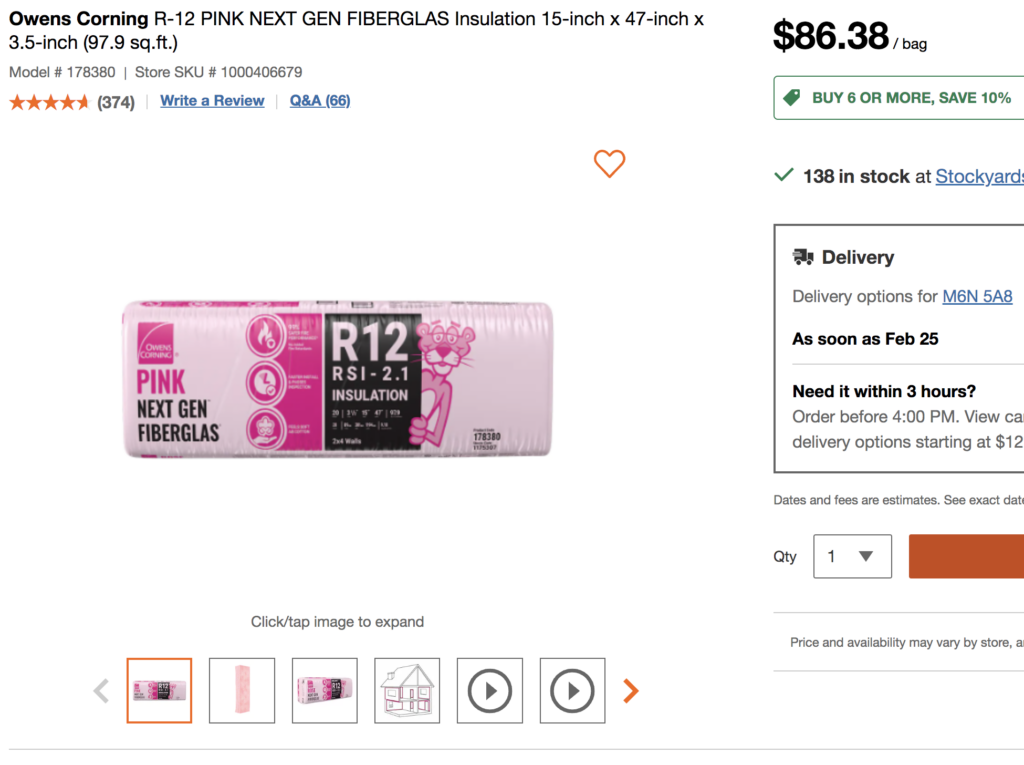
and for mineral wool with an R-14 value, it would be around $1.50 per square foot on average.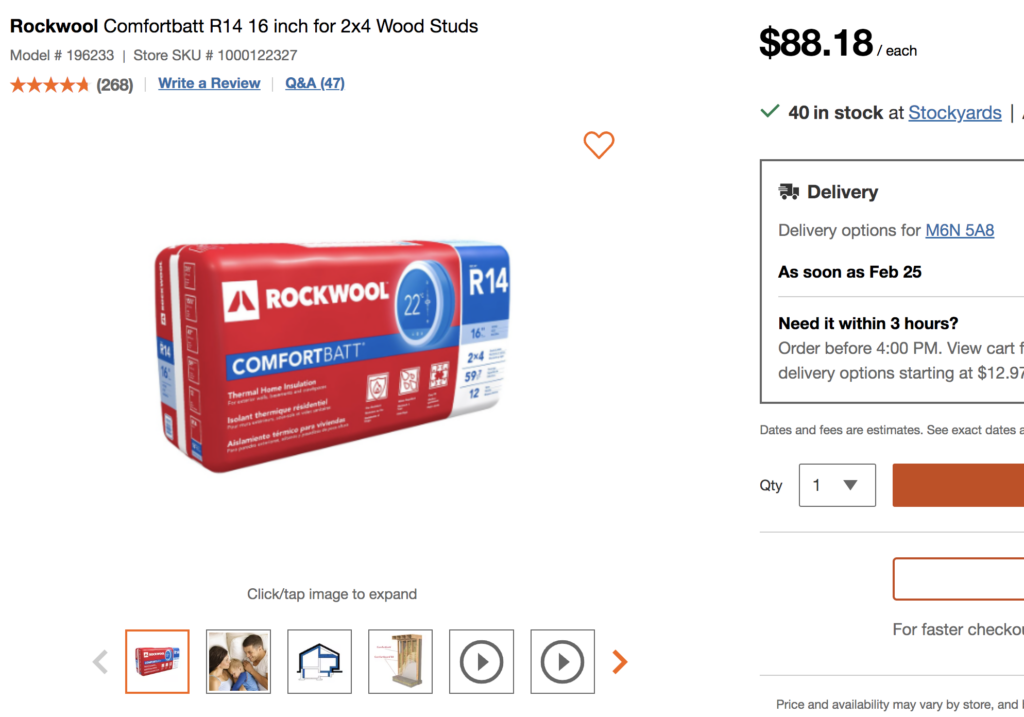
For the installation of these materials, including the vapor barrier, you would typically pay between $0.70 and $0.80 per square foot.
Additionally, the vapor barrier duct tape and acoustical sealant required around the perimeter of the walls will incur extra costs. With this in mind, if we’re paying around $4 per square foot for Rigid Foam Insulation and between $1.70 and $2.30 per square foot for batt insulation types, the average cost for insulating basement exterior walls is between $5.70 and $6.30 per square foot. Considering the space occupied, adding 2 inches of rigid insulation plus a half-inch air gap between the insulation and the 2×4 studs totals 6 inches from the exterior wall. In summary, that’s 6 inches and $5.70 to $6.30.
Another significant factor is the construction time. Considering the minimum cost of a house at $1 million, with an average of $2 million, and with a 7% interest rate plus an average down payment of 20 or 30%, the mortgage could range from $5,000 to $10,000 a month. This equates to an average daily maintenance cost of approximately $250.
Let’s say we insulate with rigid insulation and fiberglass; each type will take about two days to install. This means four days for walls that are 50 feet long on each side and 20 feet wide, totaling 140 linear feet times a 9-foot ceiling height, equating to 1,260 square feet at $5.70 per square foot, totaling $7,183. Adding in 4 days of mortgage costs at $1,000 brings us to a total of $8,182 to insulate a basement with fiberglass or $8,938 with mineral wool.
Spray Foam Insulation
We also have spray foam insulation available on the market. Spray foam comes in two types: 2LB, which is closed-cell, and 1/2LB which is open-cell. I’ll focus on closed-cell for now. Closed-cell foam prevents air, moisture, or water from penetrating, eliminating the need for a vapor barrier post-installation. A key benefit is that achieving the same R-value only requires 3.5 inches of space, saving 2.5 inches on each side of the basement walls and increasing square footage in the living area. Additionally, this insulation is made directly at the job site.
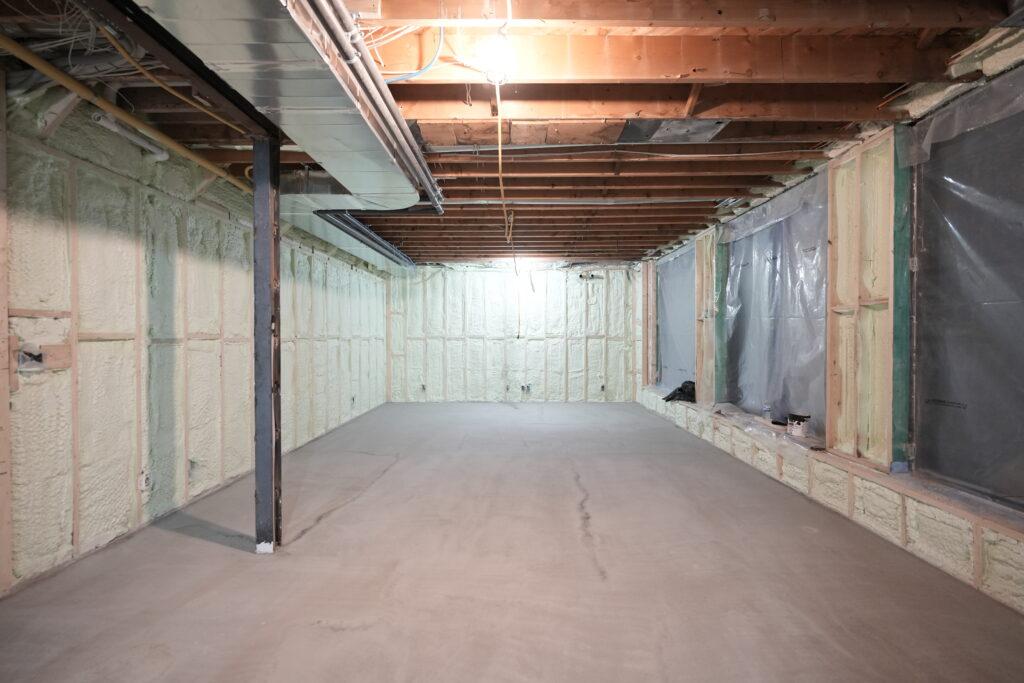
Thus, it creates an airtight envelope, expanding behind the studs to cover the entire basement walls, providing both continuous insulation and a vapor barrier simultaneously. Spray foam insulation is particularly effective in sealing beam pockets, unlike batt insulation, which often leaves gaps that allow cold air to penetrate floor cavities, leading to colder floors. The expansion of spray foam fills every crevice, achieving an airtight seal unmatched by batt insulation, which is compromised by an improperly sealed vapor barrier. This superior sealing capability significantly boosts energy efficiency and keeps floor temperatures warmer. Based on my extensive experience in construction, I consider this type of insulation to be the best. In my opinion, beam pockets cannot be insulated properly without foam.
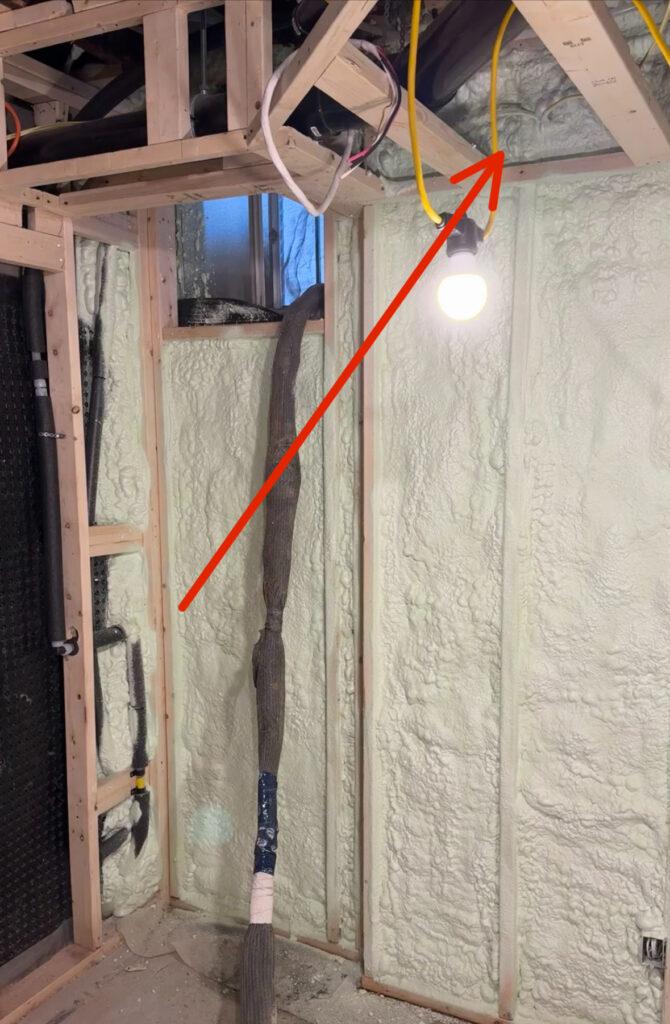
The cost for Spray Foam insulation in Toronto averages $5.25 for R20, and installation takes just one day. Multiplying this rate across an area of 140 linear feet by 9 feet totals $6,615, plus one day off your mortgage, bringing the total to less than $7,000. This means the insulation cost would be lower, and spray foam saves approximately 35 square feet of living space, significantly enhancing the house’s insulation compared to batt insulation.
A commonly mentioned drawback of spray foam is the challenge of running wires through walls, given the difficulty of cutting through high-density foam. On the other hand, fiberglass insulation requires cutting and patching the vapor barrier, a more time-consuming process. However, the need to run new wires in a new house is infrequent. Personally, I strongly advocate for spray foam insulation, although the final decision should align with your individual preferences.
Above-Grade Insulation
Shifting our focus to the above-grade levels of the house, specifically the exterior walls of the first and second floors, we encounter a different scenario. All framing above grade is structural, necessitating the use of 2×6 studs. When filling the cavity to the back wall, the choice between batt insulation and spray foam arises. Honestly, with a full 6-inch cavity filled with either fiberglass or mineral wool plus a vapor barrier, the difference isn’t significant. However, I’d lean towards recommending mineral wool for its longevity; it doesn’t degrade over time. But for those seeking an airtight environment, spray foam stands out as the superior option. Although I haven’t personally verified, I’ve heard that using spray foam could potentially lower your energy bill by about 40%, and the furnace required might be smaller, offering significant long-term savings and efficiency.
The Ontario Building Code mandates R-22 insulation values for areas above grade. For such specifications, the cost of fiberglass insulation, including labor and materials, averages around $3 per square foot, while mineral wool comes to about $4 per square foot. Installation costs for both materials range between $0.70 and $0.80 per square foot. This brings the total cost to approximately $1.40 per square foot for fiberglass and $2.25 per square foot for mineral wool.
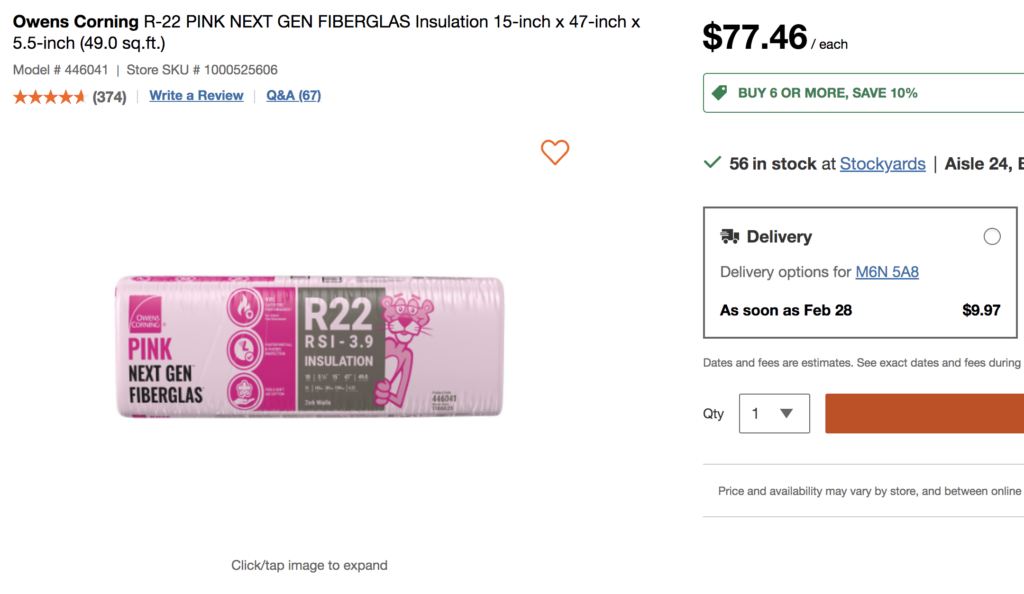
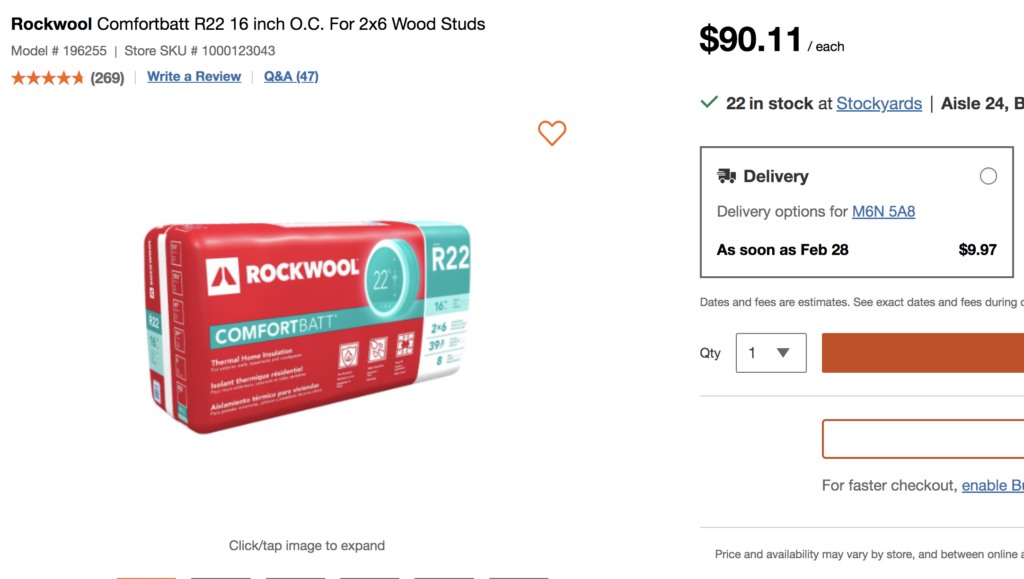
Let’s summarize the costs for insulating a two-story house with 140 linear feet of perimeter walls (50x20x2) and 20 feet high (9 feet per floor plus 1 foot of rim joist), totaling 2,800 sq ft of wall area. For R22 fiberglass insulation, the cost breaks down as follows: $0.70 for labor, $1.40 for fiberglass, and an additional $0.20 for the vapor barrier, caulking, and tack tape for all seams and joints, totaling $2.30 per sq ft. This brings the total cost to approximately $6,440 for fiberglass insulation. For mineral wool, the costs are $0.80 for labor, $2.25 for mineral wool, plus $0.20 for additional materials, totaling $3.25 per sq ft, which equates to $9,100 for mineral wool batt insulation. Choosing spray foam insulation would cost $6 per sq ft for R22, amounting to about $16,800 for 2,800 sq ft.
Installation of batt insulation and the vapor barrier will take a few days. While it may not be as airtight as spray foam, it will still pass inspection, and many builders opt for this method to meet the Ontario Building Code’s minimum requirements. Ultimately, all these methods comply with code requirements, leaving the choice of insulation up to you.
Roof Insulation
Regarding roof insulation, it’s important to remember that heat rises, making the roof a critical area for preventing heat loss. Properly insulating the roof is somewhat simpler than other areas. For non-vented flat or sloped roofs, it’s essential to use 5 1/2 inches of closed-cell foam with an R-31 value to ensure adequate insulation.
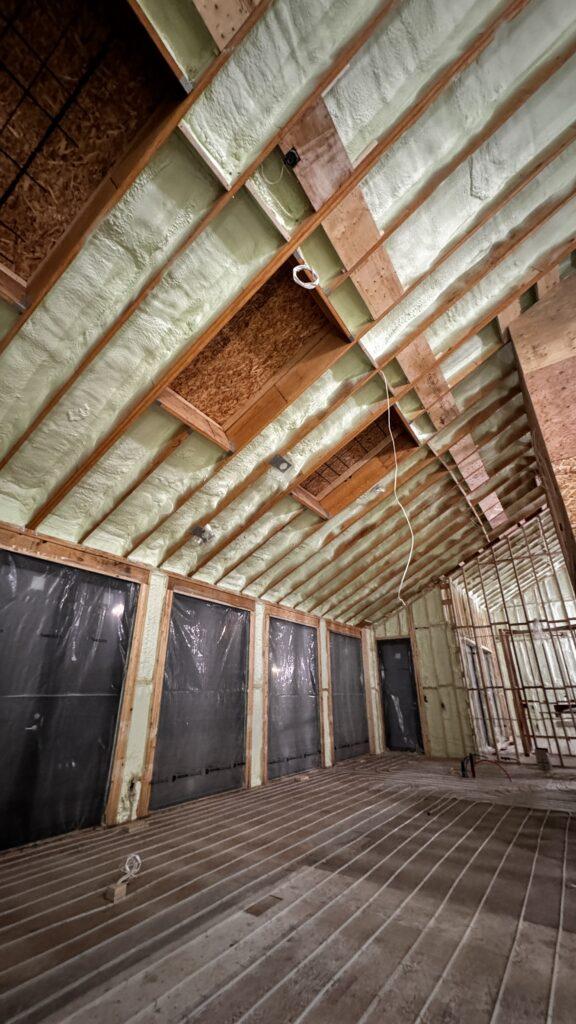
The average cost for spray foam insulation is $8.25 per square foot, leading to a total of $8,250 for a 1,000 square foot area. Modern homes, often featuring flat roofs, large windows, and contemporary exterior materials, are visually appealing and typically command a premium, selling for about 10% more than traditional homes. However, constructing with spray foam is more costly compared to using blown insulation. For example, R-60 blown-in attic insulation averages around $2.80 per square foot. This equates to approximately $2,000 for blown-in fiberglass, plus an additional $800 for the vapor barrier and baffles, covering both labor and materials for vented attic insulation.
House Insulation Costs
Adhering to the Ontario Building Code’s minimum requirements for new construction, the cost breakdown for house insulation is as follows:
- Using rigid foam for basement walls, R12 fiberglass batt insulation for the basement, R22 fiberglass batts for above-grade walls, and blown attic insulation totals approximately $15,000.
- Opting for mineral wool insulation for both below and above grade, in combination with rigid foam for the basement and blown-in attic insulation, amounts to $22,000.
- For comprehensive coverage with spray foam insulation applied below and above grade and on the flat roof, the total is estimated at $32,000, based on previous calculations.
These figures provide a general guide to the potential costs associated with different insulation strategies to meet the Ontario Building Code standards.
Renovations and Fully Gutted Houses Insulation
Having covered new construction, let’s turn our attention to renovations. In these cases, the city mandates that insulation must meet or surpass existing standards. Often, in a fully gutted house, you’ll encounter old 2x4s with minimal to no insulation, offering you a blank slate for insulation choices. For 2×4 walls, contractors typically opt for R-12 or R-14 fiberglass insulation, priced at about $2.30 per square foot. While fiberglass is perceived as cost-effective, the reality is that the combined expenses of labor, materials, and installation time are higher and less efficient compared to spray foam.
For instance, if we calculate based on 140 linear feet of perimeter walls times 30, equating to three floors, the cost for fiberglass insulation would be around $10,000 and require 3-4 days to install (adding approximately $1,000 for carrying costs). In contrast, applying 2 inches of closed-cell spray foam with the same R-value can seal the house airtight in just one day, totaling around $12,600. This demonstrates that spray foam insulation, with a 2-inch thickness, is competitively priced when compared to batt insulation. Furthermore, choosing mineral wool would entail even higher costs than spray foam. Therefore, for renovations, expect to spend about $11,000 for fiberglass insulated walls and $12,600 for spray foam insulated walls, for both below and above grade areas.
These calculations are approximate, and obviously, every house is different, leading to variations in the numbers for each project. However, as an insulation contractor with 24 years of experience, I can say that simply measuring the house and ordering the exact amount of materials is not enough. You’ll need to account for waste, as each product has a different waste percentage. Shipping materials into the house incurs extra costs. If you have leftover materials, returning them will also take time and, of course, money. Installing insulation correctly and ensuring everything is done properly is challenging, even for me after many years, as I continue to learn daily. Hiring separate trades for each insulation type, especially now when the market is down and every bricklayer, electrician, and plumber is willing to do insulation or drywall, is not straightforward. Unless you have an experienced insulation crew, I wouldn’t recommend doing it yourself or hiring an unprofessional or unreliable crew, which can be even worse. This isn’t a sales pitch to convince you to buy from us; we haven’t had a day off. My goal with this blog is to educate you on the correct insulation procedures. Insulation companies typically request drawings from the builder or homeowner and then price the job based on square footage. In my experience, 90% of these jobs go unchecked by homeowners, with only the inspector providing oversight after installation. I’ve often seen installers cutting the back of the insulation to fit wires, a practice inspectors frequently miss, leading to R-values that are less than half of the required standard. Attic insulation is rarely checked for thickness, and it’s common for installers to take shortcuts. Spray foam technicians might adjust pressure settings, compromising the material’s density, among many more tricks from unreliable workers. Sadly, I receive daily calls to correct someone else’s poor workmanship, often more than requests for new construction. The market is saturated with low-quality labor, which is disheartening and calls for caution in this industry. I want you to know that I’ve found the best tradespeople over the years, and I personally guarantee that all jobs are done to the highest standards. I check every job’s quality and rarely need to ask our crew to redo anything because they know the correct way to do their work.
In conclusion, choosing the right insulation, whether spray foam or batt, is vital for your home’s energy efficiency and comfort. My experiences have shown me the importance of proper installation, regardless of the material. Look beyond the initial costs and consider long-term benefits such as efficiency and durability. A well-insulated home doesn’t just save on energy bills; it also improves living comfort.
Thank you for reading. I hope this blog assists you in making more informed decisions for your projects. Here’s to smarter, more sustainable building.
John, Owner at Royal Insulation and Drywall.
